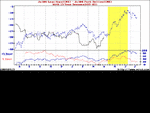Buy Jul04 Lean Hogs & Sell Jul04 Pork Bellies has historiocally been a good seasonal trade between endApril and end June (MRCI: 27Apr-22June). Profitable 14 out of 15yrs. Avg profit on winning trades: 4.5pts and optimised stop should be at $2000 (eg 5pts), not for the faint hearted.
This spread which bottomed end March at -3900 (-39cts) has recovered to -3000.
Any T2Winners with insight on this trade?
This spread which bottomed end March at -3900 (-39cts) has recovered to -3000.
Any T2Winners with insight on this trade?

